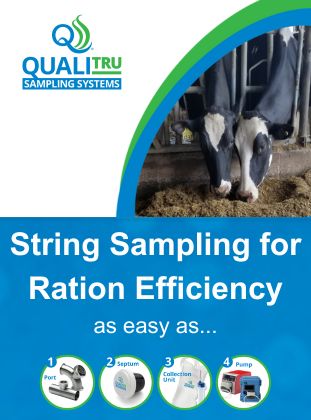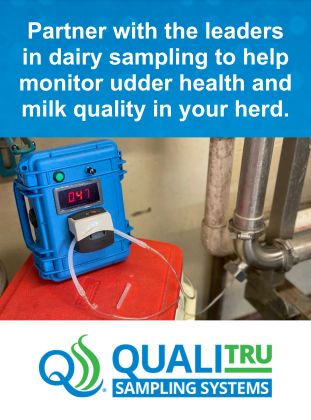Abomasal Ulcers in Dairy Calves

By Heather Smith Thomas.
Abomasal ulcers occur when there is a loss of epithelium from the surface of the abomasum. These erosions vary from mild to severe, and categorized into four groups–non-perforating with minimal clinical signs, non-perforating with significant blood loss (blood seen in the feces), perforating with localized peritonitis, and perforating ulcers with acute, diffuse peritonitis. Unfortunately, most of the cases that are recognized are in that fourth group, and many of these are only diagnosed at necropsy. Unless the calves are being closely observed, many mild cases go unrecognized until the ulcer has progressed to a point where successful treatment is difficult.
“When a calf is lost from perforated ulcers, it is often a sudden death in an otherwise seemingly healthy calf. Sometimes a few calves on the farm do poorly—and ulcers are the suspected cause. Abomasal ulcers have been reported in 32 to 76% of healthy veal calves (the ulcers being found at slaughter). Ulcers are difficult to diagnose, however, because there may be no symptoms in the live calf. There are several possible causes for these ulcers, including stress.
Dr. Murray Jelinski (Western College of Veterinary Medicine, Saskatchewan) has done several studies on abomasal ulcers over the years. He explains that cattle have 4 stomachs, but these are not all functioning in a young calf. The rumen (which digests forages via fermentation) takes time to develop. For the first weeks of life the calf depends on the abomasum to digest milk or milk replacer. This stomach is similar to the human stomach, which is also prone to ulcers.
“Some ulcers are subclinical (no outward signs) and do not affect the calf. Some bleed, and some become deep enough to perforate. Acids and digestive enzymes secreted by the stomach can literally digest a hole in the stomach wall, allowing contents of the abomasum to leak into the abdominal cavity.” This results in peritonitis, which quickly kills the calf unless the infection stays localized, walled off by the body–often resulting in an adhesion between the abomasum and the peritoneum, the omentum (the strong tissue that supports the digestive tract within the abdomen) or surrounding viscera.
“Calves with perforating ulcers are usually found dead or near death. They usually have a dime-sized hole along the greater curvature of the abomasum–the holding part of this stomach. Typically these calves are 3 to 8 weeks of age, but we see some as young as 4 days old. Ulcer formation can be very rapid,” Jelinski says.
Calves with bleeding ulcers may pass blood or partially digested blood, making feces look black. Signs of ulcers also include lethargy, colic, diarrhea, abdominal pain and distention, and grinding the teeth.
“One of the common causes of ulcers is interruption of blood supply to the lining of the stomach. If blood supply to a certain area is cut off, there would be a hole burned through the lining very quickly—within hours—due to stomach acid,” he says.
The human stomach (and abomasum in a young calf) is full of acid. It must have a healthy mucous-forming membrane lining to protect and buffer it from affects of acid. Plentiful blood supply normally bathes the lining of the gut, keeping mucus-forming cells healthy and productive. “Blood is the opposite of acid, containing bicarbonate which neutralizes acid. The stomach lining is thus a buffering zone,” he says.
Stress (due to housing situations, group mixing, weather, etc.) may be a factor contributing to ulcers in calves. Cortisone-type hormones are produced by the body in response to stress, and this response reduces gastric mucus secretion (reducing the protective effect in the stomach lining). These steroids also slow down cell renewal in the lining, which can delay healing.
Jelinski explains that the 3 to 8 week period when ulcers are most problematic is also when the rumen is developing, as the calf starts eating forage–changing from a single-stomached (monogastric) digester of milk to a ruminant.
“Some calves don’t make that transition very smoothly. They may also be licking mud or drinking dirty water from puddles, eating microbes off the ground. Some get diarrhea, and some get abomasitis or a big, bloated abomasum, and some of these conditions may lead to perforated ulcers. Some calves have a pear-shaped look to the belly and rough hair coat and look dull. Most producers think these calves have ulcers. They may or may not. You only know if a calf has ulcers by doing exploratory surgery in a live calf or a post-mortem examination,” he explains.
“Many producers when they see a dull, bloated calf assume the calf has ulcers. The few that eventually die generally do have ulcers.” But many of the calves with a bloated, sloshing abdomen eventually get better and you don’t know if they actually had ulcers or just a digestive upset that irritated the lining of the abomasum or distended this stomach for awhile.
Some dairymen feel that coarse feeds, hairballs, eating dirt, etc. irritate the gut lining and lead to ulcers, but Jelinski says these things are usually not an issue. “Ulcers form in the fundus (the bottom, food-holding area of the abomasum). Veal calves fed straw will develop shallow erosions in the pylorus (the muscular part of the stomach that mixes food), but they don’t seem to have any more incidence of ulcers in the fundus than any other calves,” he explains.
He did some research on the correlation between finding hairballs in the abomasum and finding ulcers, since this is a common theory—that hairballs may lead to ulcers. But he found no correlation between the two.
“Some calves go through bouts of abomasal dysfunction and we don’t know whether it’s an infection, or they just ate things that irritated the gut lining. People often treat them for ulcers, with various concoctions or products—everything from Keopectate to mineral oil or antacids—trying to buffer and soothe the raw lining. Some calves get better and others go on to die, in spite of treatment.” Thus it’s hard to know if these treatments actually help.
The veterinarian may open these calves up and find the abomasal lining very reddened and inflamed. “At times you wonder if this damaged tissue will even hold stitches when you try to sew it back up. In those calves, the ones we save are often poor doers and we think something chronic is going on,” says Jelenski.
Amongst all these frustrating cases, there are some actual perforating ulcers. “We think—and this is purely conjecture—that some of these irritated abomasums get so large, like a big balloon filled with water, that the blood supply becomes compromised along the greater curvature. With blood supply cut off, an ulcer forms. We put forth this theory because if you inject a latex-type dye into a dead calf, to show where circulation is, we find this area (where most ulcers occur) is also the area with the least amount of blood supply. It may be coincidence, but we don’t think it is,” he says.
One of the problems in dealing with perforating ulcers is that this happens so sporadically. A dairy or calf ranch may have several hundred calves and only 3 that have a confirmed ulcer. “So maybe the dairy starts a vaccination program to protect against a certain disease that might have caused this, or uses a mineral supplement containing copper, and the next year doesn’t have any calves that die of ulcers. They figure they solved the problem, and then a few years later they suddenly have ulcers again.” The lack of cases for a while may have been just a coincidence rather than due to the vaccine or mineral program.
Treatment is also a challenge, with suspected ulcers. If the calf has a fever or is depressed, antibiotics may be warranted. “If the calf is bright and alert but has diarrhea, he may need oral electrolytes. Some people administer oral antacid products or bicarbonate solutions, but to be effective these must be given every 3 to 4 hours. When you put bicarb into the stomach, this triggers the stomach to produce more acid to try to get back to a low pH. It starts over-producing acid. Once the buffering of the bicarb is gone, you have more acid to deal with—and it’s a vicious cycle,” he says.
“You can use tagamet or cimetidine or other H2 blockers used in humans for dealing with ulcers. There’s no doubt this would help, to knock off acid production. Once there’s an erosion and acid gets into this erosion, it forms an ulcer. An erosion is superficial, just in the mucusal lining, but with an ulcer the damage goes deeper, into the supporting tissue below it—and then into the muscle and through the other side. The acid is chewing away through these tissues, and if you can halt the acid production it heals quickly,” says Jelinski.
“No one has ever done a controlled study in calves, primarily because we don’t have a good model to incite the disease and then study it,” he says. If there was an easy way to create ulcers in a group of calves and then treat half of them and not the other half, we might be able to learn more, regarding which treatments work best.
Bicarb products can’t feasibly be given often enough to help, and giving them infrequently just makes the situation worse. “An H2 blocker makes more sense, to halt acid production. Next, you need to decide whether the calf needs antibiotics. Some people administer antibiotics as insurance, in case the erosion is infected. But the most important thing is get rid of the acid.”
Dairymen use various concoctions, but it’s hard to say how helpful these might be. Mineral oil, keopectate and Bepto Bismol are sometimes given, to coat and sooth the irritated stomach lining. “In the old veterinary literature 100 years ago people used coal oil, mineral oil, and many different things for a wide variety of ailments. Some remedies may help a little,” he says.



